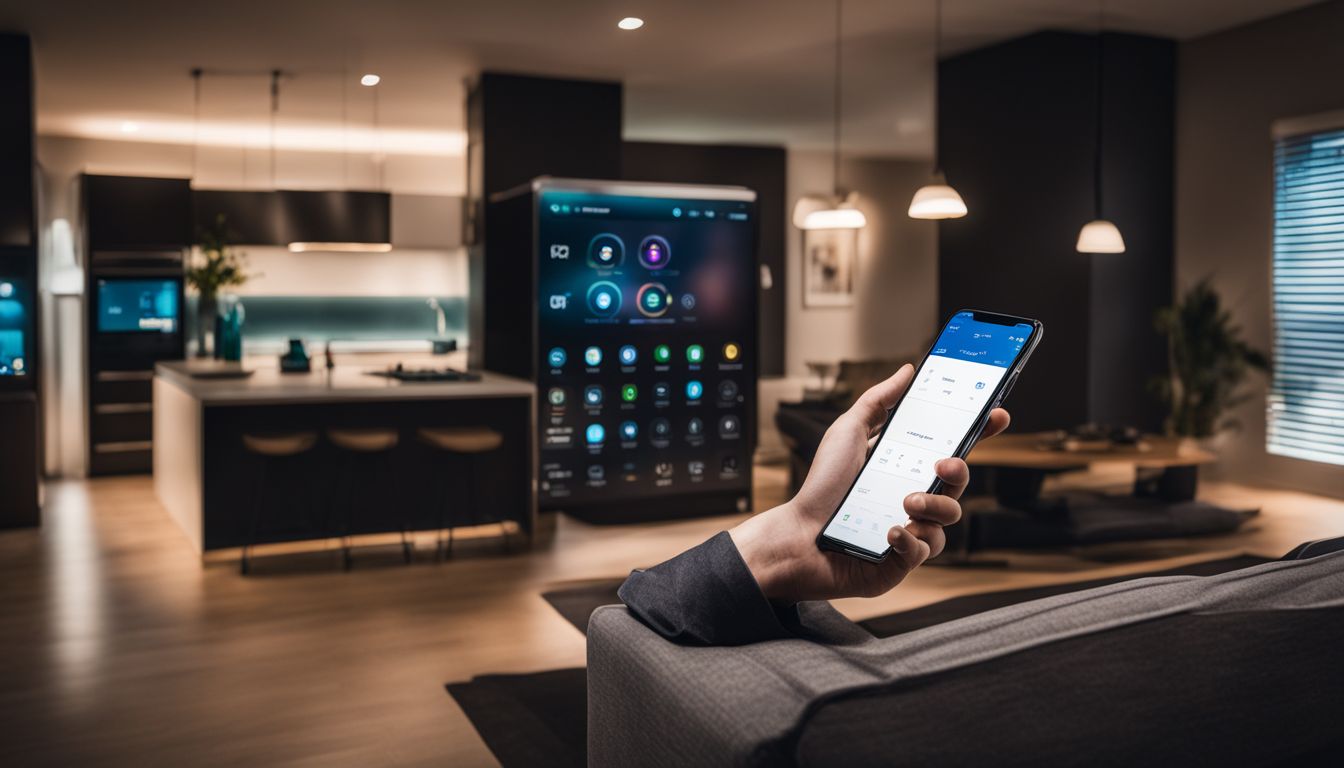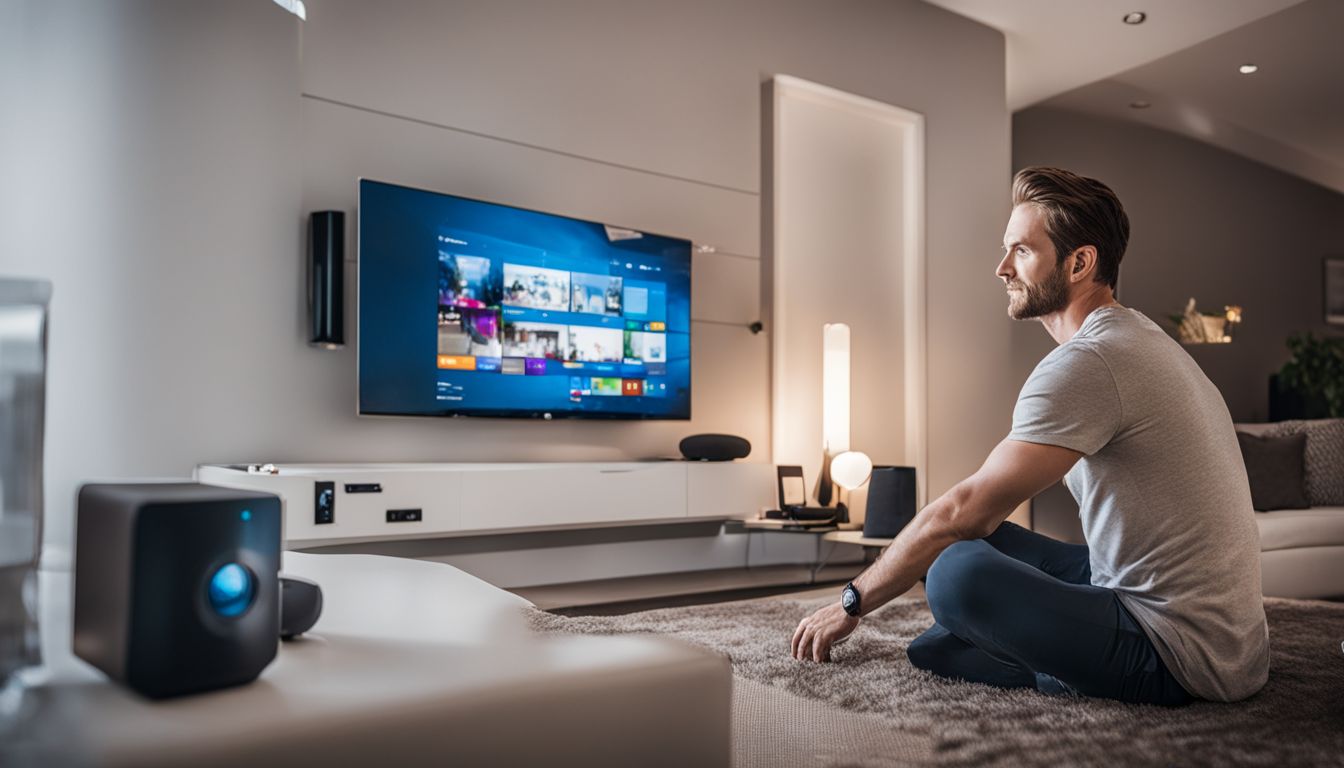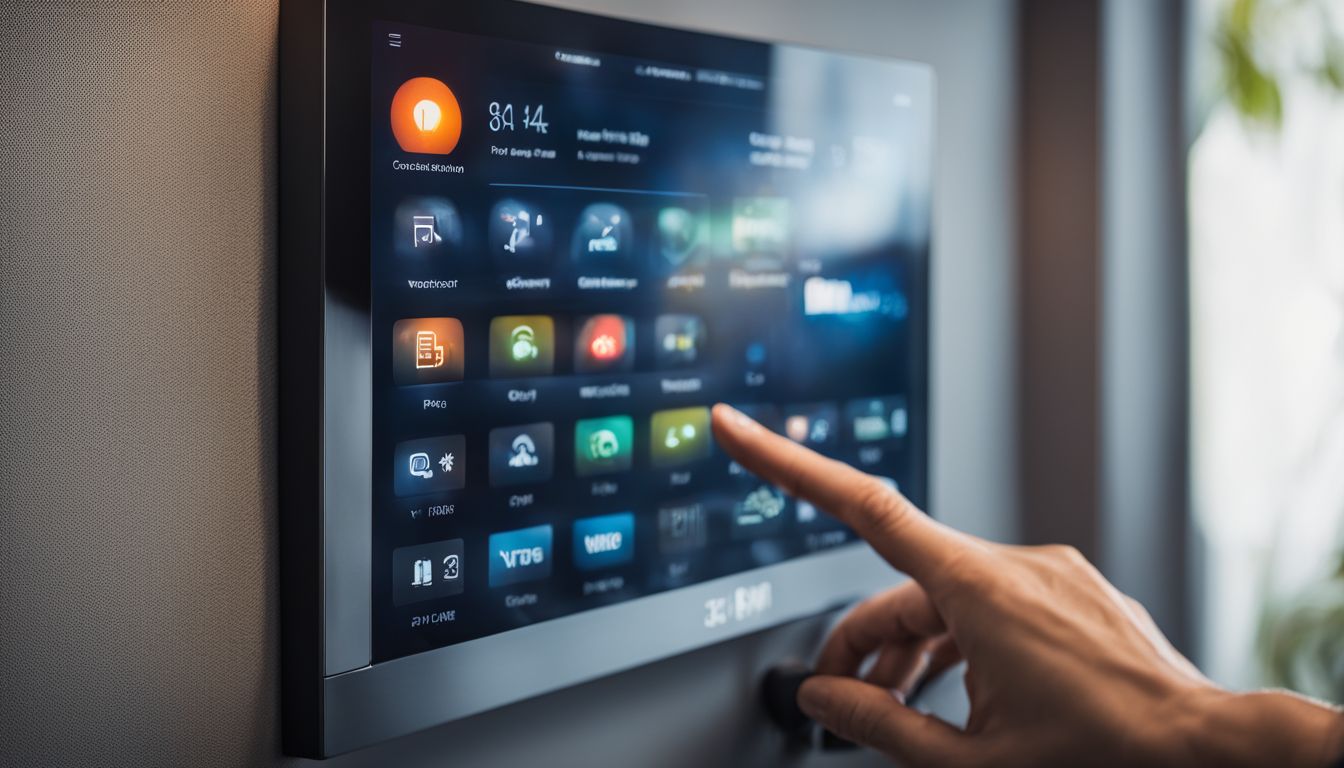Examining the Smart Home Technology: A Comprehensive Exploration
Thinking about making your home smarter? You’re not alone — more and more people are choosing to invest in smart home technology. Our comprehensive examination of the pros and cons can provide valuable insights, helping you make an informed decision.
Let’s unravel this mystery of modern living together!
Key Takeaways
- Smart homes offer increased energy efficiency by allowing users to easily control lights, heat, and air with their phone or voice, leading to lower bills and a positive impact on the environment.
- The convenience of smart home technology includes easy access to various household functions through smartphones or voice commands, remote monitoring and automation capabilities, and customizable settings for user comfort.
- Enhanced security measures provided by smart home technology include features like remote monitoring, surveillance cameras, motion sensors, and alarms that provide added protection and peace of mind. However, it’s important for homeowners to prioritize privacy and take precautions against hacking risks.
- While there are drawbacks to smart homes such as high installation costs, internet dependency for proper functioning, privacy concerns due to data collection by devices, and complicated user interfaces; with careful consideration of these factors individuals can make informed decisions about adopting smart home technology.
Pros of Having a Smart Home

Having a smart home allows for increased energy efficiency, easy access to household functions, customizable settings for user comfort, enhanced security measures, and added convenience for the elderly and differently-abled individuals.
Energy efficiency

Smart homes save energy. They use less power than normal homes. You can control lights, heat and air with your phone or voice. For instance, you don’t need to leave a light on all day.
You just tell it to turn on before you get home! This way, smart homes help lower bills and protect our world at the same time.
Ease of access

Smart home technology offers the convenience of easy access to various functionalities within your home. With just a few taps on your smartphone or using voice commands, you can control your lights, thermostat, security systems, and more.
This means no more getting up to adjust the temperature or turning off lights before bed. It’s all at your fingertips or with a simple command. Whether you’re in another room or even away from home, you can stay connected and have complete control over your environment.
Plus, it’s not just limited to one device – smart homes allow seamless integration between different devices and technologies for an effortless experience.
In addition to this ease of access, smart home technology also enables remote monitoring and automation. You can check on your appliances while at work or receive notifications if there are any unusual activities detected in your home when you’re away.
This gives you peace of mind knowing that you have full control and visibility over what’s happening in your living space even when you’re not physically there.
Customization for user comfort

Smart home technology offers customization options that enhance user comfort. With smart devices, you can create personalized settings for lighting, temperature, and even music preferences.
For example, you can program your lights to gradually dim in the evening to help you relax or set your thermostat to a comfortable temperature before you arrive home. These customizations allow you to create a living environment that suits your needs and enhances your overall comfort and well-being.
Smart home security

Smart home security is one of the key advantages of adopting smart home technology. With the integration of various devices and systems, homeowners can enhance their overall security measures.
For instance, smart home security systems often include features such as remote monitoring and surveillance cameras that allow homeowners to keep an eye on their property from anywhere through their smartphone or computer.
Additionally, some systems offer motion sensors and alarms that can notify homeowners in case of any suspicious activity. With these advanced security features, smart homes provide an extra layer of protection and peace of mind for homeowners.
While smart home security offers numerous benefits, it is important to consider potential vulnerabilities as well. As with any internet-connected device, there are risks associated with hacking and unauthorized access to personal information.
Therefore, it is crucial for homeowners to prioritize privacy and take appropriate measures to secure their networked devices. This may involve setting up strong passwords, regularly updating firmware/software, and opting for encryption technologies whenever possible.
Convenience for the elderly and differently-abled

Smart home technology offers convenience for the elderly and differently-abled individuals. With smart devices, tasks that may be physically challenging or time-consuming can now be automated or controlled remotely.
For example, adjusting lights, thermostats, and appliances can be done with a voice command or through a smartphone app. This eliminates the need to move around the house and reduces physical strain.
Additionally, smart home features like motion sensors and voice-activated virtual assistants provide assistance and enhance accessibility for those with mobility limitations. These technologies contribute to independent living for older adults and people with disabilities.
Cons of Having a Smart Home
Smart homes do have some drawbacks, such as the high installation cost, internet dependency for proper functioning, privacy concerns due to data collection by devices, and complicated user interfaces that may be difficult for some individuals to navigate.
Installation cost

Installing smart home technology can be expensive. There are costs involved in purchasing and setting up the necessary devices and systems. The initial investment may include buying smart thermostats, cameras, sensors, and other networked devices.
Additionally, you might need to hire professionals to install and configure these devices properly. Upgrading your existing infrastructure to make it compatible with smart home technology can also add to the cost.
It’s important to consider these expenses when deciding whether or not to adopt smart home technology.
Internet dependency

Smart homes rely on the internet to connect and control various devices. This means that a stable internet connection is crucial for the smooth operation of your smart home. Without an internet connection, you may lose remote access to your devices and automation features.
For example, if you’re away from home and want to adjust your thermostat or check your security cameras, it won’t be possible without the internet.
However, there are some potential downsides to this dependency on the internet. Power outages or network issues can disrupt the functioning of your smart home devices. Moreover, if your Wi-Fi router is not working properly or experiences technical glitches, it may cause interruptions in controlling your smart devices remotely.
Another concern related to internet dependency is vulnerability to hacking. Since all connected devices rely on communication technology, they can potentially be hacked if proper security measures are not in place.
It’s important to ensure that your smart home network is secure by using strong passwords and regularly updating firmware.
Privacy concerns
One important aspect to consider when it comes to smart home technology is privacy. With the increasing number of connected devices and data being collected, there are concerns about how this information is used and who has access to it.
Smart homes collect personal data like usage patterns, preferences, and even audio or video recordings that can be accessed remotely. This raises concerns about potential hacking or unauthorized access to this sensitive data.
While companies claim to have security measures in place, there is always a risk of security breaches and privacy violations. It’s crucial for users to carefully read privacy policies, understand the type of data collected, and take necessary steps to protect their personal information from misuse or unauthorized access.
Complicated user interfaces

Smart home technology offers a range of benefits, but one potential downside is the complicated user interfaces. Some smart devices and applications can be difficult to navigate and understand, especially for those who are less tech-savvy.
The multitude of options and settings can be overwhelming, leading to frustration and confusion. However, advancements in technology have led to more user-friendly interfaces, with intuitive designs and simplified controls.
It’s important for smart home manufacturers to prioritize ease of use, ensuring that anyone can easily operate their devices without any hassle or confusion.
Complicated user interfaces can deter some individuals from adopting smart home technology. People want simplicity and convenience when it comes to controlling their homes through automation systems.
They don’t want to spend time figuring out complex menus or dealing with confusing control panels. Manufacturers need to focus on creating streamlined user experiences that allow homeowners to effortlessly manage their smart devices through clear instructions, simple buttons or voice commands.
Ensuring that smart home technology has intuitive interfaces will make it more accessible and appealing to a wider audience, including older adults or those with limited technical knowledge.
By simplifying the user experience and eliminating unnecessary complications, everyone can enjoy the benefits of a smart home without feeling overwhelmed by the complexity of its interface.
Balancing the Pros and Cons of Smart Home Technology

Smart home technology has its benefits, but it also comes with some drawbacks. It’s important to consider both sides before deciding if it’s right for you. On the positive side, smart homes offer energy efficiency, convenience, and enhanced security.
You can control your devices remotely and customize settings for comfort. It’s especially helpful for the elderly or differently-abled individuals. However, there are some cons to be aware of too.
Installation costs can be high, and you’ll need a reliable internet connection for everything to work properly. Privacy concerns and complicated user interfaces are other potential issues.
Balancing these pros and cons is crucial in making an informed decision about adopting smart home technology.
Considerations for Smart Home Adoption

When considering the adoption of smart home technology, it’s important to weigh the cost versus the benefits, prioritize privacy and security measures, ensure user-friendly interfaces, and assess reliability and compatibility with existing devices.
Cost vs. benefits

The cost and benefits of smart home technology vary widely depending on the specifics of the setup. Below is a comprehensive look at the potential costs and benefits:
| Costs | Benefits |
|---|---|
| Initial outlay can be substantial, especially for high-end smart home systems. | Smart homes offer convenience, remote accessibility, enhanced security, cost savings, and customization options. |
| Requires regular updates and maintenance. | It enables the efficient operation of devices through remote control. |
| Potential need for professional installation and setup. | Smart technology brings advanced features, voice and remote control, and convenience to homes. |
| Dependency on Internet connectivity. | Can provide substantial long-term energy savings. |
| Possible compatibility issues with various technologies and devices. | Enhances the comfort and functionality of your home. |
It’s important to consider these potential costs and benefits before making a decision on smart home adoption.
Privacy and security measures

Smart home technology comes with privacy and security concerns that should be considered before adoption. Here are some important factors to keep in mind:
- Data protection: Smart home devices collect and store data about your activities, preferences, and routines. It’s crucial to choose devices that prioritize data encryption and have robust security protocols in place.
- Secure networks: Ensure your Wi-Fi network is secure by using strong passwords and regularly updating your router firmware. Avoid using default usernames or passwords for your smart home devices.
- Regular updates: Keep your smart home devices updated with the latest firmware releases. Manufacturers often release updates to address security vulnerabilities, so it’s essential to stay on top of these updates.
- Privacy policies: Before purchasing any smart home device, review the manufacturer’s privacy policy thoroughly. Make sure you understand how they collect, use, and protect your personal information.
- Two-factor authentication: Enable two-factor authentication whenever possible for an added layer of security. This usually involves a combination of something you know (password) and something you have (e.g., a unique code sent to your smartphone).
- Guest access: If you have guests or service providers who need temporary access to your smart home system, consider creating separate guest accounts with limited permissions rather than sharing your primary account credentials.
- Disable unnecessary features: Some smart home devices may come with features like remote access or voice recording capabilities that you may not need or feel comfortable with from a privacy standpoint. Disable or restrict these features if they are not essential for your needs.
User-friendly interfaces
Smart home technology offers many benefits, but it’s important to consider the user-friendliness of the interfaces. A user-friendly interface means that controlling your smart home devices is easy and straightforward.
This is especially important for elderly or differently-abled individuals who may have difficulty navigating complicated systems. With user-friendly interfaces, you can easily customize settings, control devices with a few clicks or voice commands, and access all your smart home features from a single app or hub.
The goal is to make smart homes accessible and intuitive for everyone, regardless of their technological prowess.
Reliability and compatibility
Another important consideration in adopting smart home technology is reliability and compatibility. When it comes to reliability, smart homes rely on communication technology to connect different devices and systems.
While this connectivity offers convenience, it can also introduce potential issues such as power surges or compatibility problems between devices from different manufacturers. Additionally, there may be security flaws or vulnerabilities that hackers could exploit.
Therefore, it’s crucial to ensure that the chosen smart home system is reliable and compatible with other devices in your home.
Conclusion

In conclusion, exploring the pros and cons of smart home technology allows us to make informed decisions about its adoption. While it offers convenience, energy efficiency, and enhanced security, we must also consider the installation cost, privacy concerns, and potential compatibility issues.
By weighing these factors carefully and taking necessary precautions, we can effectively leverage the benefits of smart home technology while minimizing any disadvantages.
FAQs
1. What is smart home automation?
Smart home automation is internet of things (IoT) technology that allows linking systems and devices for control over your environment.
2. What are the benefits of implementing smart home technology?
The key benefit of this tech is easy integration with other devices, allowing voice control and improved interoperability in your house.
3. Are there downsides to using Home Automation?
Yes, a major downside may be the cost of implementation as it could be costly to set everything up perfectly,
4. How will IoT affect my life at home?
Internet of Things (IoT) makes your house smarter by linking systems together; it gives you more control over various parts in your house such as light or thermostat settings.







